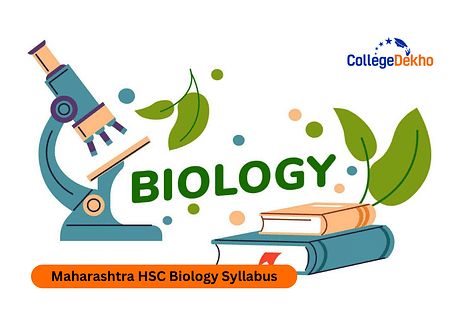

Never Miss an Exam Update
Maharashtra HSC Biology Syllabus 2025-26 is designed in align with the National Education Policy (NEP) 2020.
This aims at emphasizing more on the practical applications. The Msbshse HSC Biology syllabus is divided into two sections. Section 1 is for Botany and section 2 is for Zoology. There are 6 units and 9 chapters in Botany while 6 units and 10 chapters in Zoology. Some of the important chapters that will carry the maximum weightage in the exam are Reproduction, Genetics and Evolution, Biotechnology and its Application, and Ecology and Environment. The Maharashtra HSC Biology question paper will contain different kind of questions including, multiple choice questions, very short answer type, short answer type, and long answer questions.
Biology paper will be conducted for 70 marks and 30 marks will be allotted for the practical exams. Students will be provided 3 hours to complete the question paper. The Maharashtra HSC Syllabus 2025-26 PDF is available on the website of the Maharashtra State Board of Secondary And Higher Secondary Education. The understanding of Maharashtra State Board 12th Biology syllabus is a must, so that the students can make a preparation plan to clear the Class 12 Board exam with good grades. After completing the syllabus students must complete
Maharashtra HSC Biology Sample Paper 2026
.
You can check out major information about the Maharashtra HSC Biology Syllabus 2025-26 here:
Maharashtra HSC Biology Syllabus 2025-26: PDF
Below, we will provide the direct PDF link for the Maharashtra HSC Biology syllabus 2026 once it is released so that you can download the syllabus for the board exams. Meanwhile you can go through the last year's syllabus:
Maharashtra HSC Biology Syllabus 2025-26
Students can refer to the information about the Maharashtra HSC Biology Syllabus 2025-26 from the table given below. Make sure to complete the syllabus before the board exams and revise it accordingly.
Unit Name | Chapter Name | Content |
|---|---|---|
Section I – BOTANY | ||
Unit 1: Genetics and Evolution | Chapter 1 - Genetic Basis of Inheritance |
|
Chapter 2 - Gene: its nature, expression, and regulation |
| |
Unit 2: Biotechnology and its Application | Chapter 3 - Biotechnology: Process and Application |
|
Unit 3: Biology and Human Welfare | Chapter 4 - Enhancement in Food Production |
|
Chapter 5 - Microbes in Human Welfare |
| |
Unit 4: Plant Physiology | Chapter 6 - Photosynthesis |
|
Chapter 7 - Respiration |
| |
Unit 5: Reproduction in Organisms | Chapter 8 - Reproduction in Plants |
|
Unit 6: Ecology and Environment | Chapter 9: Organisms and Environment -I: Habitat and Niche |
|
Section II - ZOOLOGY | ||
Unit 1: Genetics and Evolution | Chapter 10 - Origin and the Evolution of Life |
|
Chapter 11 - Chromosomal Basis of Inheritance |
| |
Unit 2: Biotechnology and its Application | Chapter 12- Genetic Engineering and Genomics |
|
Unit 3: Biology and Human Welfare | Chapter 13- Human Health and Diseases |
|
Chapter 14- Animal Husbandry |
| |
Unit 4: Human Physiology | Chapter 15- Circulation |
|
Chapter 16- Excretion and osmoregulation |
| |
Chapter 17- Control and Coordination |
| |
Unit 5: Reproduction in Organisms | Chapter 18- Human Reproduction |
|
Unit 6: Ecology and Environment | Chapter 19- Organisms and Environment-II |
|
Maharashtra HSC Biology Syllabus 2025-26 for Practicals
The experiments that can be included in the MSBSHSE HSC Biology practical syllabus for the academic year 2025-26 are listed below:Maharashtra HSC Biology Experiments
- Dissect the given flower and display different whorls. Dissect anther and ovary to show number of chambers.
- Study pollen germination on a slide.
- Collect and study soil from at least two different sites and study them for texture, moisture content, pH and water holding capacity of soil. Correlate with the kinds of plants found in them.
- Study of plant population density and frequency by quadrat method.
- Prepare a temporary mount of onion root tip to study mitosis.
- Separation of plant pigments by paper chromatography.
- A) To study the rate of respiration in flower buds/ leaf tissue and germinating seeds. B) Demonstration of anaerobic respiration.
- Study the presence of suspended particulate matter in air at the two widely different Sites.
- Collect water from two different water bodies around you and study them for pH, clarity and presence of any living organisms.
- To test the presence of urea and sugar in urine.
- To test the presence of albumin and bile salts in urine.
- Study of flowers adapted to pollination by different agencies (wind, insect)
- Study of pollen germination on stigma through a permanent slide.
- To Study Mendelian inheritance using seeds of different colour/size of any plant.
- Exercise on controlled pollination Emasculation, tagging and bagging.
- Study meiosis in onion bud cell or grass hopper testis through permanent slides.
- Study of plants found in xerophytic and aquatic conditions with respect to their morphological adaptations. (Two plants each)
- Study and identify stages of gamete development, i.e. T.S. of testis and T.S. ovary through permanent slides (from any mammal).
- Study of V.S. of blastula through permanent slide.
- To study prepared pedigree charts of genetic traits such as rolling of tongue, Blood groups, widow’s peak, colour blindness.
- To identify common disease causing organisms like Plasmodium, Entamoeba, Ascaris and ring worm through permanent slides or specimens. Comment on symptoms of diseases that they cause.
- Study of animals found in xeric (desert) and aquatic conditions with respect to their morphological adaptations. (Two animals each)
Maharashtra Board Class 12 Biology Exam Pattern 2025-26
The Maharashtra Board Class 12 Biology Exam Pattern gives a guideline for students to help them prepare for the exam in an organized manner for effective results. The total marks of the Maharashtra Board 12th Biology exam are 100, out of which 70 marks are allotted for the theoretical paper and 30 marks for the practical examinations. The table below provides the parts, question categories, and grading system for the theoretical paper of the Class 12 Biology Exam.
| Maharashtra Board Class 12 Biology Exam Pattern | ||||
|---|---|---|---|---|
| Section | Type of question | Number of questions | Marks | Total Marks |
| Section A | MCQ | 10 | 1 mark for each question | 10 |
| Very Short Answer (VSA) | 8 | 1 mark for each question | 8 | |
| Section B | Short Answer (SA) | 8 out of 12 questions to be answered | 2 marks for each question | 16 |
| Section C | Short Answer (SA) | 8 out of 12 questions to be answered | 3 marks for each question | 24 |
| Section D | Long Answer (LA) | 3 out of 4 questions to be answered | 4 marks for each question | 12 |
| Total | 70 | |||
How To Download Maharashtra HSC Biology Syllabus 2025?
The official PDF of the syllabus is now available on the website of the Maharashtra State Board of Secondary And Higher Secondary Education. Students can follow the simple steps given below to download the syllabus:
- Step 1: Students will first have to visit the official website of Maharashtra State Board of Secondary And Higher Secondary Education Pune at mahahsscboard.in/index.php
- Step 2: The home page will open on your screen. You have to now click on the option called SUBJECTS AND SYLLABUS.
- Step 3: The drop-down menu will open on your screen where you have to click on the option called HSC GENERAL SUBJECT CODES & SYLLABUS
- Step 4: A new page will open on your screen where the list of subjects will be displayed. You can now download the syllabus accordingly.
Also Check
| Maharashtra HSC Previous Year Question Papers |
|---|
| Maharashtra HSC Sample Question Paper 2025 |
Maharashtra HSC Biology Syllabus 2025-26 is listed here in detail to be considered by the students for effective preparation. Check the information and start studying now.
Are you feeling lost and unsure about what career path to take after completing 12th standard?
Say goodbye to confusion and hello to a bright future!

FAQs
As per the Maharashtra HSC Biology Syllabus 2025-26, the question paper will be structured for 70 marks. 3 hours will be provided to the students to complete the question paper. The question paper will have questions from both Zoology and Botany. It will be divided into four sections.
Botany and zoology are the main areas that will be covered in the Maharashtra HSC Biology Syllabus 2025-26. Both sections will have equal units and chapters included so that the students can divide equal time between both sections and cover them thoroughly.
Unit 1: Genetics and Evolution, Unit 2: Biotechnology and its Application, Unit 3: Biology and Human Welfare, Unit 4: Human Physiology, Unit 5: Reproduction in Organisms, and Unit 6: Ecology and Environment are included in the second section of the Maharashtra HSC Biology Syllabus 2025-26.
Unit 1: Genetics and Evolution, Unit 2: Biotechnology and its Application, Unit 3: Biology and Human Welfare, Unit 4: Plant Physiology, Unit 5: Reproduction in Organisms, and Unit 6: Ecology and Environment are included in the first section of the Maharashtra HSC Biology Syllabus 2025-26.
Was this article helpful?























